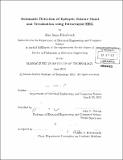Automatic detection of epileptic seizure onset and termination using intracranial EEG
Author(s)
Kharbouch, Alaa Amin
DownloadFull printable version (10.31Mb)
Other Contributors
Massachusetts Institute of Technology. Dept. of Electrical Engineering and Computer Science.
Advisor
John V. Guttag.
Terms of use
Metadata
Show full item recordAbstract
This thesis addresses the problem of real-time epileptic seizure detection from intracranial EEG (IEEG). One difficulty in creating an approach that can be used for many patients is the heterogeneity of seizure IEEG patterns across different patients and even within a patient. In addition, simultaneously maximizing sensitivity and minimizing latency and false detection rates has been challenging as these are competing objectives. Automated machine learning systems provide a mechanism for dealing with these hurdles. Here we present and evaluate an algorithm for real-time seizure onset detection from IEEG using a machine-learning approach that permits a patient-specific solution. We extract temporal and spectral features across all intracranial EEG channels. A pattern recognition component is trained using these feature vectors and tested against unseen continuous data from the same patient. When tested on more than 875 hours of IEEG data from 10 patients, the algorithm detected 97% of 67 test seizures of several types with a median detection delay of 5 seconds and a median false alarm rate of 0.6 false alarms per 24-hour period. The sensitivity was 100% for 8 out of 10 patients. These results indicate that a sensitive, specific and relatively short-latency detection system based on machine learning can be employed for seizure detection tailored to individual patients. In addition, we describe and evaluate an algorithm for the detection of the cessation of seizure activity within IEEG. Seizure end detection algorithms can enable important clinical applications such as the delivery of therapy to ameliorate post-ictal symptoms, the detection of status epilepticus, and the estimation of seizure duration. Our machine-learning-based approach is patient-specific. The algorithm is designed to search for the termination of electrographic seizure activity once a seizure has been discovered by a seizure onset detector. When tested on 65 seizures, 88% of all seizure ends were detected within 15 seconds of the time determined by a clinical expert to represent the electrographic end of a seizure. We explore the effects of channel pre-selection on seizure onset detection. We evaluate and present the results from a seizure detector that has been restricted to use only a small subset of the channels available. These channels are manually chosen to be those that show the earliest ictal activity. The results indicate that performance can suffer in many cases when the algorithm uses a small set of selected channels, often in the form of an increase in false alarm rate. This suggests that the inclusion of a full channel set allows the system to leverage information that is not readily apparent to a clinical reader (from regions seemingly not involved in the onset) to better differentiate ictal and inter-ictal patterns. Finally, we present and evaluate an algorithm for patient-specific feature extraction, where the feature extraction process for a given patient leverages the training data available for that patient. The results from an evaluation of a detector that supplemented the original spectral energy features with features computed in a patient-specific manner show a significant improvement in 3 out of 5 patients. The results suggest that this is a promising avenue for further improvement in the performance of the seizure onset detector.
Description
Thesis (Ph. D.)--Massachusetts Institute of Technology, Dept. of Electrical Engineering and Computer Science, 2012. Cataloged from PDF version of thesis. Includes bibliographical references (p. 87-90).
Date issued
2012Department
Massachusetts Institute of Technology. Department of Electrical Engineering and Computer SciencePublisher
Massachusetts Institute of Technology
Keywords
Electrical Engineering and Computer Science.